Ardenna pacifica
IUCN
LCBasic Information
Scientific classification
- name:Ardenna pacifica
- Scientific Name:Ardenna pacifica,Wedge-tailed Shearwater ,Puffin du Pacifique
- Outline:Waterfowl
- Family:
Vital signs
- length:About 46 cm
- Weight:390-570g
- lifetime:About 29 years
Feature
The mouth is slender, the nose tube is short, the wing tips are long, and the tail is wedge-shaped and longer
Distribution and Habitat
It is found in the tropical, subtropical and temperate waters of the Pacific and Indian Oceans between 35 degrees north and south latitude, from Ogasawara Islands, Iwo Jima Islands, Hawaii Islands, Revillaghedo Islands, China's Penghu Islands, south to the coast and islands of Australia, Including Cape Nachulalister, Cocos Islands, Kermadec Islands, Seychelles Islands, Norfolk Island and Lordhhow Island. It also roams the Izu Islands, the Arabian Sea, the Red Sea, and occasionally New Zealand during the non-breeding season. China is found only in Taiwan and the Penghu Islands.
Place of origin: Australia, British Indian Ocean Territory, China, Cocos Islands, Colombia, Ecuador, Fiji, French Polynesia, Guam, Guatemala, Honduras, India, Indonesia, Japan, Kenya, Kiribati, Madagascar, Malaysia, Maldives, Marshall Islands, Mauritius, Mexico, Micronesia, Mozambique, Sinkari Donia, Nicaragua, Norfolk Island, Northern Mariana Islands, Oman, Palau, Papua New Guinea, Philippines, Reunion I
Appearance
It is 46 cm long, has a wingspan of 97-105 cm, and weighs 390-570 g. Both sexes similar, medium size. The beak is thin, the nasal tube is short, the wings are long and pointed, and the tail is also long and wedge-shaped. There are two types of body plumage: light type dark-brown forehead, crown, nape and upper body, black primary flight feathers and tail, and dark brown upper wing coverts and flight feathers. Chin, throat, front neck and lower body white. The underwing coverts are also white, with blackish-brown spots, the axillary feathers are pure white, the iris is dark brown, the mouth is pale pink, the apex is black, and the feet are pale red; Dark type has dark brown body, black flight and tail feathers, brown overlying wings, brown iris, lead-gray beak and pink feet.
In this medium and large seabird, the feathers have a variety of color patterns. However, in many regions, the dark type tends to be majority or dominant, such as the North Pacific region, which is close to 100%
Details
Ardenna pacifica: Wedge-tailed Shearwater, Puffin du Pacifique, no subspecies. Until 2014 it was classified in the genus Puffinus under the scientific name "Puffinus pacificus". . It was classified into the genus Ardenna in 2014.

Cuneiform shearwaters are resident birds, but often wander aimlessly after breeding. In the tropics, wedge-tailed shearwaters are usually resident birds. At the northern and southern ends of their range, on the other hand, these birds show greater mobility, and they tend to migrate to the warmer waters of the Pacific and Indian Oceans.
The Shearwater is mainly active at night and at dusk. It often flies in groups at low altitudes over the sea. Sometimes it glides on the surface of the sea tilting left and right, and sometimes it flaps its wings quickly between the peaks. Around the shoals of fish, wedge-tailed shearwaters congregate with black terns and red-footed boobies. They benefit from the cooperation of dolphins and turtles, and on the other hand, near the Hawaiian Islands, they benefit from the theft of small frigate birds.
The wedge-tailed shearwater most often fish in flight and then dive through simple contact with the surface of the water. Catch aquarium/flying-fish.html">flying fish in the air. In the Seychelles, wedge-tailed shearwaters can dive, they can dive to a depth of 66 meters. In Australia, these birds travel long distances to bring food for their young. The female dives lower than the male. The amount of food varies mainly according to the physical condition and the length of the trip. The stronger shearwaters have better food quality and larger portions. The weaker wedgetail did not perform as well and ate a lighter diet. The former brought back a mixed menu of fish and cephalopods, while the latter only brought back cephalopods of lower nutritional quality.

The shearwater is silent at sea and rarely calls in flight. However, they can be very noisy when they are on the ground or near caves, when the sounds they make are divided into two distinct parts that can be transcribed as oooooo-err. The Shearwater feeds mainly on small fish and cephalopods. Foraging is mainly through swimming and diving, often swimming while foraging for animal food on the surface of the water, but also from flying to the surface of the water suddenly to hunt food found in the air. Will also follow the ship foraging. It mainly feeds on small fish and cephalopods of the genus Mullidae. They also eat small amounts of insects and crustaceans. In Hawaii, studies of the stomachs of certain wedge-tailed shearwaters yielded results of 67 percent fish, 29 percent cephalopods and 1 percent crustaceans.
The breeding season depends on the region, usually between September and April of the following year. In the Hawaiian Islands from early March to November, in southern Australia from August to late May of the following year. It breeds on small islands or coasts in warm oceans, especially on grassy, rocky, and sandy islands. They nest in rocky caves on islands or on the ground, or under rocks and shrubs, and some cunetail shearwaters nest in bare sandy ground or low vegetation, and in Australia they even nest on the ground in island forests. They usually nest together in groups.
Each brood lays 1 egg, white, 63 mm ×41 mm in size and weighs about 60 grams. Incubation lasts 48-63 days. The fleece is brownish grey to pale yellow. The food that parents bring home for each meal weighs about 20 to 72 grams. When the baby bird grows to between 392-440 grams in weight, it takes about 105 days to fly. However, the maximum weight of the young birds peaks at 77 days old, when they weigh 500-575 grams.

Shearwater infanticide occurs when food is scarce. Most nests become weak and collapse within the first year, which results in 75% of the tunnels being repaired. Burrows surrounded by tree roots at the entrance are stronger and can withstand years of exercise. The species reaches sexual maturity at 4 years of age and has a maximum lifespan of 29 years, so parents can have up to 25 offspring in their lifetime.
In 2004, the global population was estimated to be over 5.2 million. In 2009, population sizes in some countries were estimated at 50-10,000 shearwaters migrating to Taiwan, China; 10,000-100,000 pairs of adult wedge-tailed shearwaters and 1,000-10,000 individual wedge-tailed Shearwaters migrate to Japan.
Listed on the IUCN Red List of Threatened Species (IUCN)2018 ver3.1 - Not Threatened (LC).
Protect wild animals and eliminate wild meat.
Maintaining ecological balance is everyone's responsibility!








